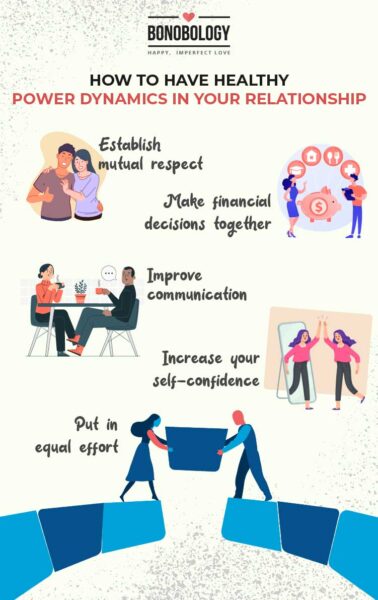Knowingly or unknowingly, every couple plays power games. Power dynamics in relationships can work both ways. One, when a partner dominates the other with the latter willingly suppressing his or her desires in exchange for what s/he considers security or love. And then there is the other end of the spectrum where there are men and women who snatch power from their partners in abusive or manipulative ways. While total equality in relationships is just a utopian dream, at times it becomes necessary to manage these equations. As counseling psychologist Kavita Panyam (Masters of Psychology, International Affiliate with the American Psychological Association), who has over two decades of experience in relationship counseling, says, “Power struggles happen in relationships all the time. Couples can go to great lengths to test who brings more love to the table in a relationship. There are also cases where people are seen to get a high watching the anguish on their partner’s face as they release and curtail their feelings.” Simply put, there are various ways in which people in love show power over who they love.
What Is A Power Dynamic In A Relationship?
When the word ‘power’ is used in the context of relationships, it actually points out the lack of balance. While power dynamics’ meaning can change according to the varied contexts and circumstances, at the very basic level, it points to the ability to influence or direct the behavior of others in a particular way. She explains this point with a case study of Sharanya, a doctor. Hailing from a conservative family, Sharanya would always refuse guys fearing they were being frivolous. Things changed when a nice young man, Akash, entered her life and started wooing her persistently. “But she would say no without evaluating her facts, leading him to gradually withdraw. When she eventually warmed up to him, he had become wary of her,” she says. In this instance, initially, Sharanya had the upper hand but when she climbed down her high horse, he had moved away from her. This is one minor example of how differing expectations and attitudes can lead to a mismatch between couples. Examples of power dynamics in everyday life don’t revolve around major events most of the time. They can be as subtle as Sharanya not paying any heed to Akash’s advances. But most often, power dynamics in relationships boil down to negotiations, the way it happens in business deals. Each partner comes with his or her own set of beliefs and behavioral patterns, and needless to say, wants the other to change to his or her tunes. What does power look like in a relationship, you may be wondering? A common example is when one partner earns significantly more than the other. That partner would want to control all the finances and have the upper hand in handling expenditure. In a healthy relationship, these decisions would be taken together by both partners. But in a relationship where power between husband and wife is always contested, it could lead to wanting to control the decision-making.
What Are The Types of Power Relationships?
Incidentally, power dynamics in relationships are not set in stone. “Power” on its own cannot be termed to be good or bad, it’s the impact on a relationship that makes all the difference. Ultimately what matters is how your partner makes you feel – do you feel empowered enough to grow, remain happy and content, or do the power games make you stressed out? Understanding power dynamics in relationships means taking note of the various ways in which couples negotiate power.
1. Positive power
In the positive sense, power and control in relationships can mean one person taking charge, solving problems, getting things done and taking care of the other emotionally. Now, this might not be a relationship of equals but there is a good chance of it succeeding because there is a positive influence of a person on the other. On other occasions, power struggles can actually help you grow. For instance, if a couple is ready to understand and accept their differences, is willing to draw boundaries and stick by them and knows that a certain amount of compromise might be necessary for a relationship to move forward, it is an example of positive power dynamics in relationships. In such a case, a couple is not seeking equality nor are they trying to exert their supremacy over the other. They are merely accepting their differences while bringing their strengths to the table. There would be a struggle to underline the rule of the dynamics but once they are set, they can actually contribute to their growth.
2. Negative power
When the power equations are completely skewed to favor one partner, they can be termed as negative power dynamics in relationships. Needless to say, this sort of power is always unbalanced and one partner constantly remains in awe or in fear of the other. Negative power can be wielded in many ways. It need not be always related to abuse or violence (which is its most obvious manifestation). But they are visible in small incidents as well. For instance, all the decisions from the smallest matters to the biggest ones being made by one person alone, being shouted down by the dominant partner, giving the cold shoulder or silent treatment during arguments are examples of negative power dynamics in everyday life. It must not seem pretty obvious to you that from the types of power dynamics in a relationship, this one has the most potential of developing a toxic relationship. What essentially happens here is that one partner tries all tactics to control the other. Threats, stalking behavior, mistrust are all different forms of negative power dynamics at work.
3. Imbalanced power
Agreed, a perfectly balanced relationship is a rarity. In fact, one can say it is a utopia. Every relationship has a bit of imbalance but the key is to see that it does not trip into negative territory. Imbalanced power equations arise when the power is vested in one partner’s hands most of the time. For example, a man may often have the last say in everything in the household. To show he is ‘kind and caring’ he might consult his wife and discuss things but it’s more of a formality because, in the end, it’s his word that rules. In a traditional family setup, this scenario is very common. An imbalance in power may or may not result in a clash but such a dynamic is definitely not desirable. Often, the submissive partner may accept his or her better half’s beliefs without question, be easily susceptible to manipulation and persuasion and have very little say in a situation. Imbalanced power dynamics in relationships generally occur when one person is completely dependent on the other. In some cases, a power imbalance in relationships may lead to a dramatic retaliation from the submissive partner. Such power plays in a marriage often harm it, since the dominant partner won’t take lightly to any such retaliation. Types of power dynamics in relationships, as you’ve seen, can have multiple outcomes depending on how the power is wielded and just how much of a mismatch there is. Let’s find out if it’s possible to have healthy power dynamics in relationships and how to go about securing them.
How To Have Healthy Power Dynamics In Relationships?
To have a healthy relationship, a certain amount of equality is essential. Even research proves this statement. A study published by Czech researchers Jitka Lindova, Denisa Prusova and Katerina Klapilova in the Journal of Sex and Marital Therapy, found that power-balanced couples tended to have better quality and happier relationships, though the perception differed from men to women. Power distribution affected perceived relationship quality, especially among men, while among women, lower perceived relationship quality was associated with their partners’ control and personality dominance. When there are negative power dynamics in a relationship, it may affect the submissive partner’s mental health severely. A study by professors at the University of Wisconsin and the University of Notre Dame claims that the demand-withdrawal dynamic leads to spousal depression in many situations. In such a dynamic, one partner demands a change and the other partner withdraws from the situation, essentially denying any such requests and exercising the imbalanced power play in a marriage. When there is a level playing field, there tends to be more mutual respect between couples, more honest communication and more attention to decision making that makes both parties satisfied and content. But how does one achieve this neat balance and have healthy power dynamics in relationships? Here are some suggestions
1. Respect each other
This goes without saying perhaps. Respect and trust are the foundations of any strong relationship. To have healthy power dynamics, you need to respect your partner’s beliefs and statements. This does not mean you agree with everything you say to each other but accept the differences and respect their views. If there is a disagreement, learn to disengage and handle the situation tactfully instead of trying to prove yourself right all the time. Showing respect in a relationship can be as easy as making sure they feel heard, by not cutting them off and offering understanding before advice. Never have contempt for each other’s feelings, desires, ideas or needs. Examples of power dynamics in everyday life can be seen if one partner has no regard for what the other has to say, and is quick to disregard his/her opinion. Of course, life cannot always be smooth and there might come a point when you feel the differences are too big to be bridged but even so the way you react makes all the difference. Divorce or separations aren’t ugly words anymore but if push comes to shove, you can go your respective ways without making it an ego battle. Basically, even if the love flies out of your life, let the respect remain.
2. Decide on money matters
A lot of times, power dynamics in relationships are determined by money. The partner who earns more has the upper hand, period. Even in relationships where the couple earns equally well, there might come an occasion when one member tries to prove their power over the other. The reason is that they are not dependent on each other so feel they do not need to adjust or compromise in any way. Healthy power dynamics can be established if couples decide to treat money matters in the right spirit. It might seem like they are negotiating a deal but having clarity about money helps. Money issues can ruin your relationship, so it’s important to approach this with care. So if this means, taking a hard call on expenditure, investments, purchases etc, so be it. This way neither feels shortchanged nor will they believe that their contribution is more and that they are receiving less than what they have invested financially and emotionally.
3. Develop good communication
One of the hallmarks of unhealthy or imbalanced power dynamics in relationships is the lack of communication between couples. When one member exerts unreasonable power over the other, the first casualty is communication. The suppressed member feels scared or hesitant to voice his or her opinion. Worse, they may have no say in any matter. To have healthy power dynamics, both partners should have the freedom to address issues without any fear. The freedom to speak your mind is the key to a happy relationship. This does not mean you enter into slanging matches, giving back word for word when you have an argument. Power between husband and wife can more often than not be determined by who’s afraid of communicating their feelings to who. Communication should be directed at seeking a solution, not to show who has the upper hand. When couples argue, they try to show their power over each other and try to quieten the other person. But a relationship isn’t a battle to be ‘won’ or ‘lost’.
4. Increase your self-confidence
One of the major reasons why power dynamics in relationships are so imbalanced is because of the lack of confidence or low self-esteem of one of the partners. When you do not think highly of yourself, you easily give away the power to others. To maintain the equilibrium or bring back the balance in your relationship, work on yourself first. Develop a healthy relationship with yourself, learn to communicate your needs clearly and effectively to wrest back the control that you may have lost. Healthy power dynamics mean you are secure enough to know when to give in and when to stand your ground. Setting and following healthy boundaries are part of these steps. Blurred boundaries mean you are often taken for granted and you may end up doing things that you do not want to. Learn to say ‘No’ and more importantly, accept a ‘No’ from your partner.
5. Both of you should strive to meet relationship needs
Relationships are all about give and take. You have to give as much as it is your right to take. A relationship that has healthy power dynamics will ensure that you get returns on your emotional investment. This can happen only when both partners have some common relationship goals and are willing to put in the effort to meet each other’s needs. Even if you do not feel like meeting every need of your partner but if taking certain steps might be useful for the future of the relationship, go ahead and invest yourself into it. For instance, a couple might differ on parenting measures. Perhaps you don’t agree with the methods advocated by your husband. But if your overall goal is to ensure the healthy upbringing of your child, at times, it is worthwhile to go by what he says. Relationships are complex and they need to be negotiated with great skill all the time. The power dynamics may change from time to time but if the feelings are strong, the real power will be brought about by the love you share. Realizing your own power as well as that of your partners is the key to a balanced and healthy bond. We hope you now have the answer to ‘What does power look like in a relationship?’ so you can better judge the power dynamics of your own relationship.



